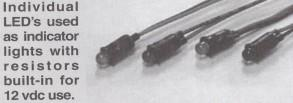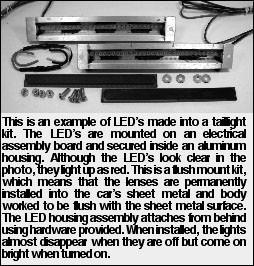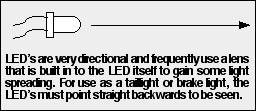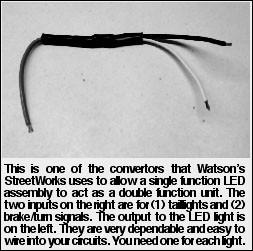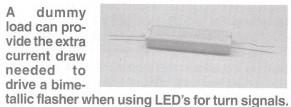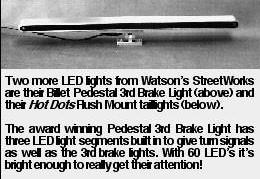Shine Light on LEDs Leave a comment
Here’s a PDF Download of this article.
So, What is all this Fuss about LED Lights
By Steve Watson & Harvey Richardson
Lighting on the earliest cars was done with either kerosene or carbide lamps. It didn’t take long
for Edison’s light bulb to find its way onto the automobile. For nearly 100 years the incandescent
bulb has been the only choice for lighting your car. LED lights were first invented in the 1960s
and in the last decade have made huge strides in automotive applications. But what is an LED
and why is it so different and better than regular incandescent bulbs?
What is an LED, anyway?
An LED (which is usually pronounced as the letters L.E.D. but also is used as an acronym
pronounced like the metal, “lead”) is a Light Emitting Diode – a semiconductor device that emits
light when a voltage is applied (typically 2.1 volts dc). LEDs work differently than Edison’s bulb.
Two big differences are heat and polarity. Old style bulbs waste 90% of the energy they use
producing unwanted heat. They are bi-directional, meaning where you attached the positive and
negative doesn’t matter. As long as there is current passing through it the bulb will glow. LED
produce much less heat for the same amount of light. That translates into much less current
draw. LEDs are polarity sensitive. They have a positive side and a negative side. If you wire
them backwards, they don’t work.
When they are properly grouped into a cluster or strip, LED’s make great lights and have
become the favorite choice for center high mount third brake lights in both OEM and aftermarket
applications. Individual LED’s also make great indicator lights for automotive use. Since an
individual LED is usually a 2.1 volt item, in order to use it as an indicator, a resistor must be
added. Most LED’s sold as indicators already have the resistor installed for 12 vdc use. When
put into clusters or strips, 4 or 5 LED’s plus a smaller resistor are wired in series to give the
correct voltage drop for 12 vdc.
What advantage is an LED Taillight/Brake light?
An LED produces more light from less amperage and voltage, comes on almost
instantaneously, creates nil heat compared to an incandescent bulb and typically lasts 100,000
hours when used within its correct voltage range. That’s what makes them different and better.
Less amperage use helps to relieve the strain placed on car electrical systems. An LED’s faster
response time means that drivers behind us know more quickly that we are stopping. Their low
heat allows them to be located in tight spots. And their long life costs less over the life of the car.
O.K. There must be a catch. What’s wrong with LED’s?
Well, it’s not that they have anything wrong but that they are different than an incandescent
bulb, (like an 1157) and we have to realize that in order to use them properly.
First, LED’s give out one color of light (one specific wavelength). So they come in red, yellow,
green, etc. That is why they don’t work well with blue-dots, red light going through a blue lens
gives you next to nothing. This is also why LED’s are used with a clear lens or one that matches
the LED color, red LED’s in a red plastic housing, amber in amber, etc., this assures maximum
transmission of light through the lens.
Second – As opposed to incandescent bulbs, LED’s are very directional and are used with a
lens (which is actually part of the LED in most cases) to get some spreading of the light. A 20-
degree spread LED is common. As a result, to use LED’s for a brake light or full taillight, the
LED’s must point straight toward the rear of the car where we want them to be seen. Install
them into a slanted fender surface and they will not be visible very far behind the car.
The third issue with LED’s is this – by nature they are a single function light, either on or off. In
order to use them as a taillight that needs two functions (taillight plus brake light/turn signal) we
must have two different groups of LED’s to do the two different functions – or – we have to trick a
single group of LED’s into doing both functions by using a little devise called a converter.
Nothing more than a small group of electronic components, the converter steps down the
voltage to the LED’s slightly for the taillights, and gives full voltage for the brake/turn signals. It
also keeps those two circuits from cross-talking to each other.
Finally, the small amperage drawn by LED’s may not “drive” a regular automotive flasher used
for the turn signals. “Can” flashers work by having amperage warm an internal bimetallic strip.
The strip heats up and breaks the circuit, cools down and completes the circuit. This happens
about 90 times a minute to give the flashing effect. To solve this problem you need either (1)
extra current draw provided by keeping bulbs for the front end or resistors called dummy loads
(think of them as extra lights that don’t light up), or (2) a special “no-load” flasher that will work
with LED’s.
Will incandescents and LED’s work together?
Yes, but maybe not -sounds like a stupid answer, but let me explain. If an LED light is properly
made, it is just one more component in the electrical system and will work perfectly in
conjunction with incandescent bulbs. However, there are LED lights on the market that work
only as a complete system, only with LED lights and only with lights from the same
manufacturer. That is fine if that is what you want for your car. But what if you want to keep the
bulbs in the front of the car and just add LED taillights? Then those “system” lights are not for
you. They force you to use only that brand of light and prevent combining lights to get the effect
you are after. Be sure to ask before you buy to make sure that what you are getting will achieve
your goals. At StreetWorks, all of our LED lights are made to work in combination with any other
bulb or light.
In summary, when we make taillight modifications to our car or truck, we can use numerous
combinations of lights and types of lights to achieve the look that we want. But we must be
aware of the correct parts that are needed with each of those combinations to achieve the
taillight functionality that we need. If LED’s are part of your plans, understanding the
characteristics of LED lights will help assure that you take full advantage of their unique benefits
and end up with neat, bright taillights for your ride. Enjoy!
Here’s a PDF Download of this article.


